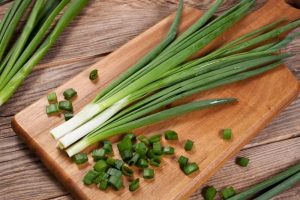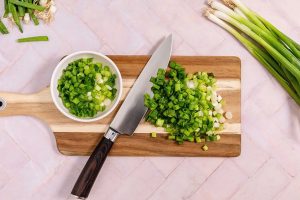
1. Origin and Main Growing Regions
Scallions originated in Central Asia and Siberia, later spreading to China, India, and Southeast Asian countries, including Vietnam. In Vietnam, scallions are grown in many regions across the country. However, some areas are particularly known for their scallion production and quality, including:
- Ha Tinh: Considered the major scallion-growing area of the province, with concentrated farming in districts like Can Loc.
- Nghe An: Especially the coastal area of Quynh Luong, famous for its indigenous Phu Luong scallion variety with a distinctive aroma.
- Hanoi: The Vong Xuyen area (Phuc Tho district) is also a scallion-growing region that provides good income for local people.
- The Mekong Delta provinces also have significant scallion production.
Scallions can be grown year-round, but yields are usually higher during the dry season.

2. Nutritional Value
Scallions are not just a seasoning; they also offer many health benefits due to their rich nutritional content. According to research, scallions contain:
- Vitamin K: Good for bone health and blood clotting.
- Vitamin C: A powerful antioxidant that boosts the immune system and helps with iron absorption.
- Vitamin A: Important for vision and the immune system.
- Folate (Vitamin B9): Necessary for cell development and especially important for pregnant women.
- Fiber: Supports the digestive system, lowers cholesterol, and may reduce the risk of heart disease and diabetes.
- Minerals such as potassium, magnesium, and copper.
In addition, scallions contain compounds like allicin and allyl sulfide, which are believed to have anti-cancer and antibacterial properties.
Reduce blood sugar
- The sulfur compounds in green onions have the ability to produce insulin and increase it, thereby preventing the risk of diabetes.
Improve the digestive system
- It is no coincidence that green onions have become a very popular appetizer. Few people know that green onions contain a lot of fiber, making digestion easier. In particular, green onions are easy to combine with many types of vegetables while still bringing a delicious feeling to the person enjoying them.
Improve your figure
- Eating green onions regularly not only reduces the accumulation of bad cholesterol but also burns excess fat inside the body. Therefore, green onions will help you have a slim figure.
Support eyesight
- Carotenoids and vitamin A in green onions help prevent the risk of vision loss, helping the eyes to always maintain their inherent sharpness.

3. Dishes They Accompany
Scallions are a versatile ingredient used in many Vietnamese dishes to add flavor and garnish. Some dishes that commonly feature scallions include:
- Soups: Chopped scallions are sprinkled on top to enhance aroma and color.
- Stir-fries: Scallions are added at the end of the cooking process or used as an ingredient in the stir-fry.
- Porridge (Cháo): Scallions are an indispensable seasoning for many types of congee.
- Fresh spring rolls (Gỏi cuốn): Blanched scallions are used to secure the ingredients inside the rolls.
- Scallion oil (Mỡ hành): A sauce made from fried scallions in oil, often served with woven vermicelli (bánh hỏi), grilled ark clams (sò lông nướng), grilled corn (bắp nướng), etc.
- Vietnamese savory crepe (Bánh xèo): Scallions are added to the filling and used for garnish.
- Many grilled dishes: Scallions or scallion oil are often served with grilled items like grilled oysters with scallion oil (hàu nướng mỡ hành).
4. Main Export Markets
Vietnam has significant potential for exporting herbs and spices, including scallions. According to statistics, the export value of onions, chives, and garlic from Vietnam has seen considerable growth.
China is currently the largest import market for onions, chives, and garlic from Vietnam. Besides this, other markets also have potential, such as Southeast Asian countries and some markets in Asia.
To enhance exports, Vietnam needs to further focus on product quality, packaging processes, and brand building to meet international standards and expand markets.
In summary, scallions are not only an indispensable part of Vietnamese cuisine but also a high-nutritional agricultural product with export potential, contributing to the country’s economic development.
Other articles:
Other agricultural products:


